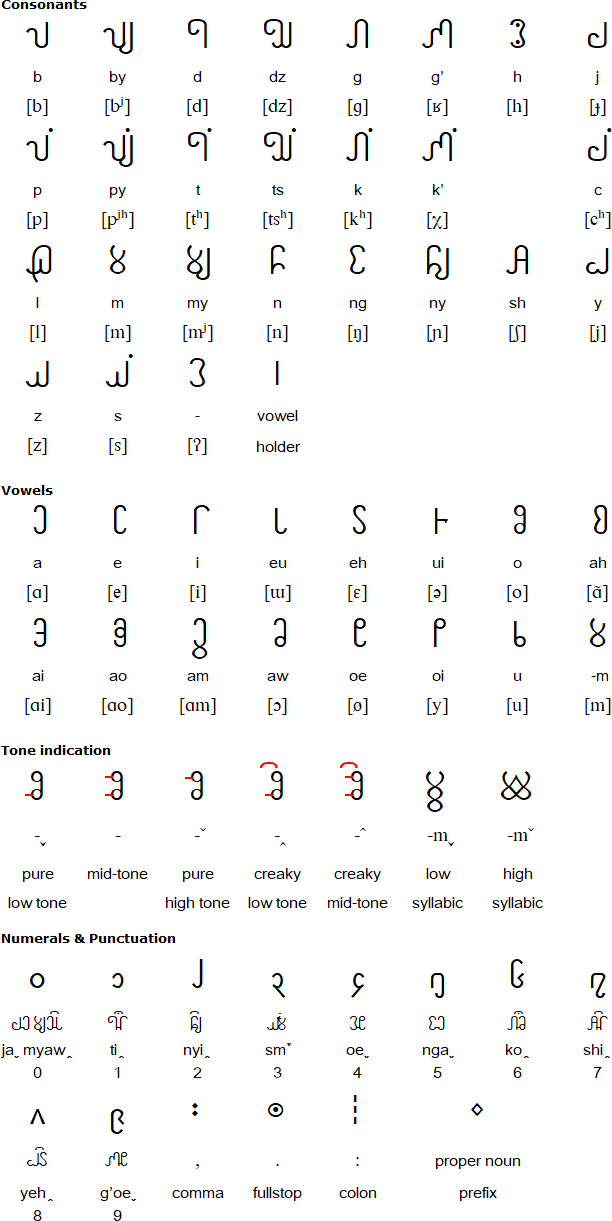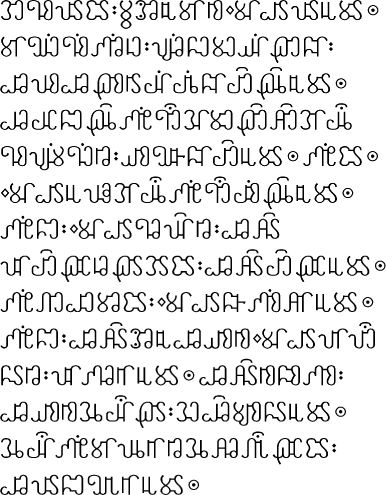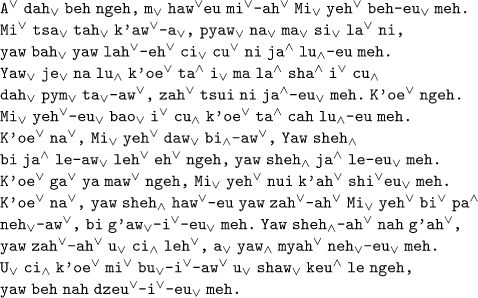The New Akha alphabet is an alternative way of writing the Akha language, a Southern Loloish language spoken in China, Myanmar, Laos, Thailand and Vietnam. It was devised by Ian James. There are a number of other methods of writing Akha using the Latin, Thai, Burmese and Lao scripts.
Part of Ian's aim was to create a script which looked both authentically historic and reasonably sophisticated. The design is based on ancient Pallava/Brahmi, the parent of almost all scripts of Southeast Asia. But while the consonants are clearly derived (and will be somewhat familiar to readers of Tai- and Mon-based languages), the vowels and tones are necessarily specific to Akha.
The consonant phonemes are listed here with the international phonetic symbol and the 'Baptist Akha' romanization. Some of these can be devoiced, shown by the addition of a dot above. Unless in the presence of a creaky vowel-tone (see below), those will also be aspirated (breathy):
Syllables end in vowels (are coda-less), except for those few with final /-m/. Some vowels are paired with lip-rounded versions. A few diphthongs are used in borrowed words.

Download a script chart for New Akha
Download a font for the New Akha alphabet (TrueType, 11K)
If one syllable glides smoothly into a second syllable which has only a vowel, the bridging vowel-holder consisting of a vertical bar is used in lieu of a consonant. Otherwise, initial vowels have the glottal plosive as their consonant.
Tones are at one of 3 pitches. Their markers are written as joiners between the consonant and vowel, helping to shape a syllable into a unit glyph. The addition of a 'creaky' symbol over the basic tone symbol gives a shorter, throaty effect to the vowel. If one of the devoiced consonants is involved, the creakiness caps any aspiration.
The vowel /o/ is used as an example to hang off the tone marker. The /m/ phoneme can also fill a syllable, and then like a vowel can also take a tone; there are special forms for solo low and high syllabic /m/.
For numerals, it may be sufficient to borrow the local Burmese (modified slightly), or try a new set based loosely on the Thai.


The romanized extract represents the opening passages of the Bible (Genesis) is the sample given at www.language-museum.com
Information about Akha | Numbers | Tower of Babel | New Akha script
Akkhara Muni, Amethyst, Bostani, Elektrum, Fontok, Klaekson-Zaen, Maui, New Akha, New Maori, New Mong, Pranish, SIGIL, Sigil Panel Script, Slinseng-Fi, Tengwar for Scottish Gaelic, Xylphika
See also: http://www.skyknowledge.com/orthographies.htm
Constructed scripts for: Ainu | Arabic | Chinese languages | Dutch | English | Hawaiian | Hungarian | Japanese | Korean | Lingala | Malay & Indonesian | Persian | Tagalog / Filipino | Russian | Sanskrit | Spanish | Taino | Turkish | Vietnamese | Welsh | Other natural languages | Colour-based scripts | Tactile scripts | Phonetic/universal scripts | Constructed scripts for constructed languages | Adaptations of existing alphabets | Fictional alphabets | Magical alphabets | A-Z index | How to submit a constructed script
[top]
You can support this site by Buying Me A Coffee, and if you like what you see on this page, you can use the buttons below to share it with people you know.

If you like this site and find it useful, you can support it by making a donation via PayPal or Patreon, or by contributing in other ways. Omniglot is how I make my living.
Note: all links on this site to Amazon.com, Amazon.co.uk
and Amazon.fr
are affiliate links. This means I earn a commission if you click on any of them and buy something. So by clicking on these links you can help to support this site.
[top]